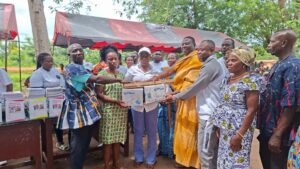A bold Ready-to-Use Therapeutic Foods (RUTF) initiative signals ambition, but success hinges on political will, financing, and system resilience
By Jones Morkeh Anlimah
On September 18, 2025, Ghana charted a new course in its fight against child malnutrition with the launch of a ground-breaking project that aims to treat 90 percent of children suffering from severe acute malnutrition nationwide. The initiative, officially titled “Accelerating Access to Ready-to-Use Therapeutic Foods to Address Undernutrition through Sustainable Delivery Strategies,” could mark a decisive shift in how the country tackles one of the most pressing threats to child survival.
For years, the treatment of malnourished children in Ghana has leaned heavily on donor funding and short-term interventions. Now, with the Ghana Health Service partnering the Eleanor Crook Foundation and the Clinton Health Access Initiative, the government is seeking to embed Ready-to-Use Therapeutic Foods (RUTF) into the national health system for the very first time.
The Urgency of Action
The numbers paint a worrying picture. According to the 2022 Demographic and Health Survey, six percent of Ghanaian children under five are wasted, with 1.2 percent severely wasted-equivalent to more than 61,000 children at risk of death each year. Northern, Ashanti, and Volta regions show even higher prevalence, exposing regional inequalities that deepen the crisis. Globally, wasting is responsible for more than one million child deaths annually, making it among the most severe yet preventable threats to child health.
This initiative therefore carries both national urgency and global relevance. By including RUTF on the Essential Medicines List, in Standard Treatment Guidelines, and under the National Health Insurance Scheme (NHIS), Ghana is signaling that nutrition treatment is no longer a temporary fix but a long-term public health priority.
Building on Early Gains
There is reason for cautious optimism. In its first phase, the revised national project CMAM (Community-based Management of Acute Malnutrition) guidelines, trained over 80 master trainers, and procured 13,000 cartons of RUTF at 30 percent lower cost than before. Investments in solar-powered weighing scales and MUAC tapes have strengthened early detection, improving chances of survival for children caught in time.
These achievements prove that targeted investments can stretch limited resources and deliver tangible impact. But scaling up to reach 90 percent coverage will demand much more.
The Roadblocks Ahead
The path to success is littered with challenges. Ensuring consistent nationwide supply of RUTF, especially to remote communities, will test Ghana’s fragile supply chain systems. NHIS financing, while promising, must be both reliable and timely to address bottlenecks.
Beyond logistics and funding, human capacity and awareness are critical. Health workers must be trained to detect and treat cases effectively, while caregivers need education to recognize symptoms early. Without grassroots engagement, many children will still slip through the cracks.
Beyond Treatment: Tackling the Roots of Malnutrition
Experts warn that while treatment is essential, prevention must not be sidelined. Malnutrition is rarely just about lack of food and it is intertwined with poverty, food insecurity, poor sanitation, and limited maternal and child healthcare. A holistic response requires stronger food systems, investments in clean water and sanitation, and programs that support mothers before and after childbirth.
Only by addressing these root causes can Ghana break the cycle of undernutrition and reduce its dependence on therapeutic foods in the long run.
A Game Changer with Global Implications
International partners have hailed Ghana’s move as bold and transformative. Dr. Yashodhara Rana of the Eleanor Crook Foundation described the country’s pledge to finance and scale wasting treatment through its own health system as a “game changer,” one that could inspire other African nations to pursue sustainable, government-led solutions to malnutrition.
The initiative also feeds directly into the United Nations’ Sustainable Development Goals, mainly SDG 2 (Zero Hunger) by reducing child wasting, SDG 3 (Good Health and Well-being) by lowering child mortality, and SDG 10 (Reduced Inequalities) by extending services to underserved regions. Perhaps most importantly, it also exemplifies SDG 17 (Partnerships for the Goals), showing how global collaboration can empower local ownership.
A Promise That Must Be Kept
At its heart, this project is more than a policy, it is a promise. A promise that Ghana will no longer allow children to die from preventable malnutrition. A promise that investments will be made in the youngest citizens to secure their right to survive and thrive. And a promise that the country will shift from donor dependency to true self-reliance.
But promises require action. Achieving 90 percent coverage will demand unwavering political will, adequate financing, and resilient health systems. Every successful treatment represents not just a life saved, but a step toward a healthier, more resilient nation.
Ghana’s nutrition drive, if realized, will not only change the fate of thousands of children but could also set a precedent across the continent. The stakes could not be higher: it is about justice, survival, and the future of an entire generation.






